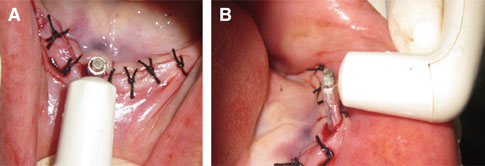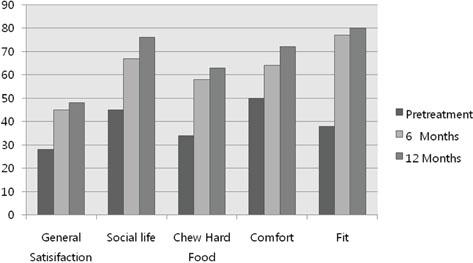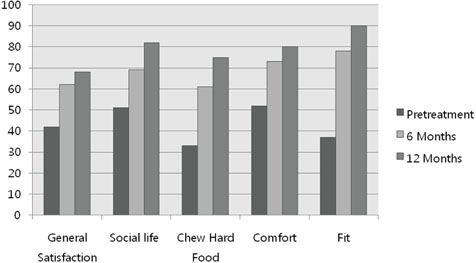J Adv Prosthodont.
2015 Jun;7(3):191-198. 10.4047/jap.2015.7.3.191.
Comparison of marginal bone loss and patient satisfaction in single and double-implant assisted mandibular overdenture by immediate loading
- Affiliations
-
- 1TMD Center, INI Hospital, Hannover, Germany. saratavakolizadeh@yahoo.com
- 2Hamadan University of Dental Science, Hamadan, Iran. fvafaee@gmail.com
- 3Periodontist, Tehran, Iran.
- KMID: 2284704
- DOI: http://doi.org/10.4047/jap.2015.7.3.191
Abstract
- PURPOSE
The purpose of this study was to compare the coronal bone level and patient satisfaction in 1-implant and 2-implant assisted mandibular overdentures.
MATERIALS AND METHODS
Twenty patients who had maladaptive mandibular dentures were treated in this study. Patients were randomly divided into two groups. The first group received 1 implant (Simple line II, Implantium, South Korea) in their mandibular midline and the second group received 2 implants in their B and D regions (according to Misch's category). If the primary stability of each implant was at least 60 ISQ, ball attachment was placed and denture relined with soft liner. After 6 weeks, retentive cap incorporated with hard acrylic resin. In the 6 and 12 months recalls, periapical digital radiograph were made and visual analogue scale questionnaires were used to record patient satisfaction. The Friedman test was done for comparing the presurgical and postsurgical parameters in each group and the U-Mann Whitney test (P<.05) was done for comparison of post-treatment results between the two groups.
RESULTS
All implants achieved sufficient primary stability to be immediately loaded. Patient satisfaction was high, and there were no significant differences between two groups (P>.05). In addition, mean marginal bone loss was 0.6 +/- 0.67 mm in the first group and 0.6 +/- 0.51 mm in the second group, after 12 month. Mean marginal bone loss showed no significant differences between two groups.
CONCLUSION
This preliminary one-year result indicated that mandibular overdentures anchored to a single implant can be a safe and cost-effective method as a starting step for implant-overdenture treatment.
Keyword
Figure
Reference
-
1. Redford M, Drury TF, Kingman A, Brown LJ. Denture use and the technical quality of dental prostheses among persons 18-74 years of age: United States, 1988-1991. J Dent Res. 1996; 75:714–725.2. Dias R, Moghadam M, Kuyinu E, Jahangiri L. Patient satisfaction survey of mandibular two-implant-retained overdentures in a predoctoral program. J Prosthet Dent. 2013; 110:76–81.3. Preciado A, Del Río J, Suárez-García MJ, Montero J, Lynch CD, Castillo-Oyagüe R. Differences in impact of patient and prosthetic characteristics on oral health-related quality of life among implant-retained overdenture wearers. J Dent. 2012; 40:857–865.4. Cochran DL. The evidence for immediate loading of implants. J Evid Based Dent Pract. 2006; 6:155–163.5. Stephan G, Vidot F, Noharet R, Mariani P. Implant-retained mandibular overdentures: a comparative pilot study of immediate loading versus delayed loading after two years. J Prosthet Dent. 2007; 97:S138–S145.6. Kacer CM, Dyer JD, Kraut RA. Immediate loading of dental implants in the anterior and posterior mandible: a retrospective study of 120 cases. J Oral Maxillofac Surg. 2010; 68:2861–2867.7. Attard NJ, Zarb GA. Immediate and early implant loading protocols: a literature review of clinical studies. J Prosthet Dent. 2005; 94:242–258.8. Burns DR, Unger JW, Coffey JP, Waldrop TC, Elswick RK Jr. Randomized, prospective, clinical evaluation of prosthodontic modalities for mandibular implant overdenture treatment. J Prosthet Dent. 2011; 106:12–22.9. Visser A, Raghoebar GM, Meijer HJ, Batenburg RH, Vissink A. Mandibular overdentures supported by two or four endosseous implants. A 5-year prospective study. Clin Oral Implants Res. 2005; 16:19–25.10. Batenburg RH, Raghoebar GM, Van Oort RP, Heijdenrijk K, Boering G. Mandibular overdentures supported by two or four endosteal implants. A prospective, comparative study. Int J Oral Maxillofac Surg. 1998; 27:435–439.11. Payne AG, Tawse-Smith A, Kumara R, Thomson WM. One-year prospective evaluation of the early loading of unsplinted conical Brånemark fixtures with mandibular overdentures immediately following surgery. Clin Implant Dent Relat Res. 2001; 3:9–19.12. Daas M, Dubois G, Bonnet AS, Lipinski P, Rignon-Bret C. A complete finite element model of a mandibular implant-retained overdenture with two implants: comparison between rigid and resilient attachment configurations. Med Eng Phys. 2008; 30:218–225.13. Feine JS, Carlsson GE, Awad MA, Chehade A, Duncan WJ, Gizani S, Head T, Lund JP, MacEntee M, Mericske-Stern R, Mojon P, Morais J, Naert I, Payne AG, Penrod J, Stoker GT, Tawse-Smith A, Taylor TD, Thomason JM, Thomson WM, Wismeijer D. The McGill consensus statement on overdentures. Mandibular two-implant overdentures as first choice standard of care for edentulous patients. Int J Oral Maxillofac Implants. 2002; 17:601–602.14. Liddelow GJ, Henry PJ. A prospective study of immediately loaded single implant-retained mandibular overdentures: preliminary one-year results. J Prosthet Dent. 2007; 97:S126–S137.15. Cheng T, Sun G, Huo J, He X, Wang Y, Ren YF. Patient satisfaction and masticatory efficiency of single implant-retained mandibular overdentures using the stud and magnetic attachments. J Dent. 2012; 40:1018–1023.16. Cordioli G, Majzoub Z, Castagna S. Mandibular overdentures anchored to single implants: a five-year prospective study. J Prosthet Dent. 1997; 78:159–165.17. Liu J, Pan S, Dong J, Mo Z, Fan Y, Feng H. Influence of implant number on the biomechanical behaviour of mandibular implant-retained/supported overdentures: a three-dimensional finite element analysis. J Dent. 2013; 41:241–249.18. Passia N, Wolfart S, Kern M. Six-year clinical outcome of single implant-retained mandibular overdentures - a pilot study. Clin Oral Implants Res. 2014; 05. 29.19. Jokstad A, Carr AB. What is the effect on outcomes of time-to-loading of a fixed or removable prosthesis placed on implant(s)? Int J Oral Maxillofac Implants. 2007; 22:19–48.20. Quality evaluation for dental care: guidelines for the assessment of clinical quality and professional performance. Los Angeles: California Dental Association;1977. p. 61–64.21. Misch CE. Contemporary of implant dentistry. 3rd ed. St. Louis: CV Mosby;2008. p. 299–310. p. 65322. de Grandmont P, Feine JS, Taché R, Boudrias P, Donohue WB, Tanguay R, Lund JP. Within-subject comparisons of implant-supported mandibular prostheses: psychometric evaluation. J Dent Res. 1994; 73:1096–1104.23. Dent CD, Olson JW, Farish SE, Bellome J, Casino AJ, Morris HF, Ochi S. The influence of preoperative antibiotics on success of endosseous implants up to and including stage II surgery: a study of 2,641 implants. J Oral Maxillofac Surg. 1997; 55:19–24.24. Susarla SM, Chuang SK, Dodson TB. Delayed versus immediate loading of implants: survival analysis and risk factors for dental implant failure. J Oral Maxillofac Surg. 2008; 66:251–255.25. Stricker A, Gutwald R, Schmelzeisen R, Gellrich NG. Immediate loading of 2 interforaminal dental implants supporting an overdenture: clinical and radiographic results after 24 months. Int J Oral Maxillofac Implants. 2004; 19:868–872.26. Komiyama A, Klinge B, Hultin M. Treatment outcome of immediately loaded implants installed in edentulous jaws following computer-assisted virtual treatment planning and flapless surgery. Clin Oral Implants Res. 2008; 19:677–685.27. Szmukler-Moncler S, Piattelli A, Favero GA, Dubruille JH. Considerations preliminary to the application of early and immediate loading protocols in dental implantology. Clin Oral Implants Res. 2000; 11:12–25.28. Naert I, Gizani S, Vuylsteke M, Van Steenberghe D. A 5-year prospective randomized clinical trial on the influence of splinted and unsplinted oral implants retaining a mandibular overdenture: prosthetic aspects and patient satisfaction. J Oral Rehabil. 1999; 26:195–202.29. Tokuhisa M, Matsushita Y, Koyano K. In vitro study of a mandibular implant overdenture retained with ball, magnet, or bar attachments: comparison of load transfer and denture stability. Int J Prosthodont. 2003; 16:128–134.30. Taylor TD. Indications and treatment planning for mandibular implant overdntures. In : Fiene Js, Carlsson GE, editors. Implant overdentures as the standard of care for edentulous patients. Chicago: Quintessence;2003. p. 71–81.31. Fueki K, Kimoto K, Ogawa T, Garrett NR. Effect of implant-supported or retained dentures on masticatory performance: a systematic review. J Prosthet Dent. 2007; 98:470–477.32. Geertman ME, Boerrigter EM, Van't Hof MA, Van Waas MA, van Oort RP, Boering G, Kalk W. Two-center clinical trial of implant-retained mandibular overdentures versus complete dentures-chewing ability. Community Dent Oral Epidemiol. 1996; 24:79–84.33. Kronstrom M, Davis B. Immediate functional loading of 1 or 2 dental implants supporting a ball retained mandibular overdenture: Interim results of a randomized prospective study. J Oral Maxillofac Surg. 2010; 68:e15.34. Roos J, Sennerby L, Lekholm U, Jemt T, Gröndahl K, Albrektsson T. A qualitative and quantitative method for evaluating implant success: a 5-year retrospective analysis of the Brånemark implant. Int J Oral Maxillofac Implants. 1997; 12:504–514.
- Full Text Links
- Actions
-
Cited
- CITED
-
- Close
- Share
- Similar articles
-
- Implant and root supported overdentures - a literature review and some data on bone loss in edentulous jaws
- Clinical evaluation of mandibular implant overdentures via Locator implant attachment and Locator bar attachment
- Implant overdenture of mandible with severe unilateral atrophy: Report of two cases
- Finite Element Analysis of Stress Distribution on Telescopic System for Mandibular Implant Supported Overdenture
- Causes of failed implant attachments and application of double crown implant overdenture in one patient









